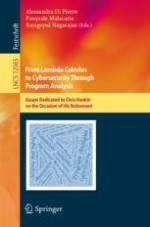2020 | OriginalPaper | Chapter
Cathoristic Logic
A Logic for Capturing Inferences Between Atomic Sentences
Authors : Richard Evans, Martin Berger
Published in: From Lambda Calculus to Cybersecurity Through Program Analysis
Publisher: Springer International Publishing
Activate our intelligent search to find suitable subject content or patents.
Select sections of text to find matching patents with Artificial Intelligence. powered by
Select sections of text to find additional relevant content using AI-assisted search. powered by
